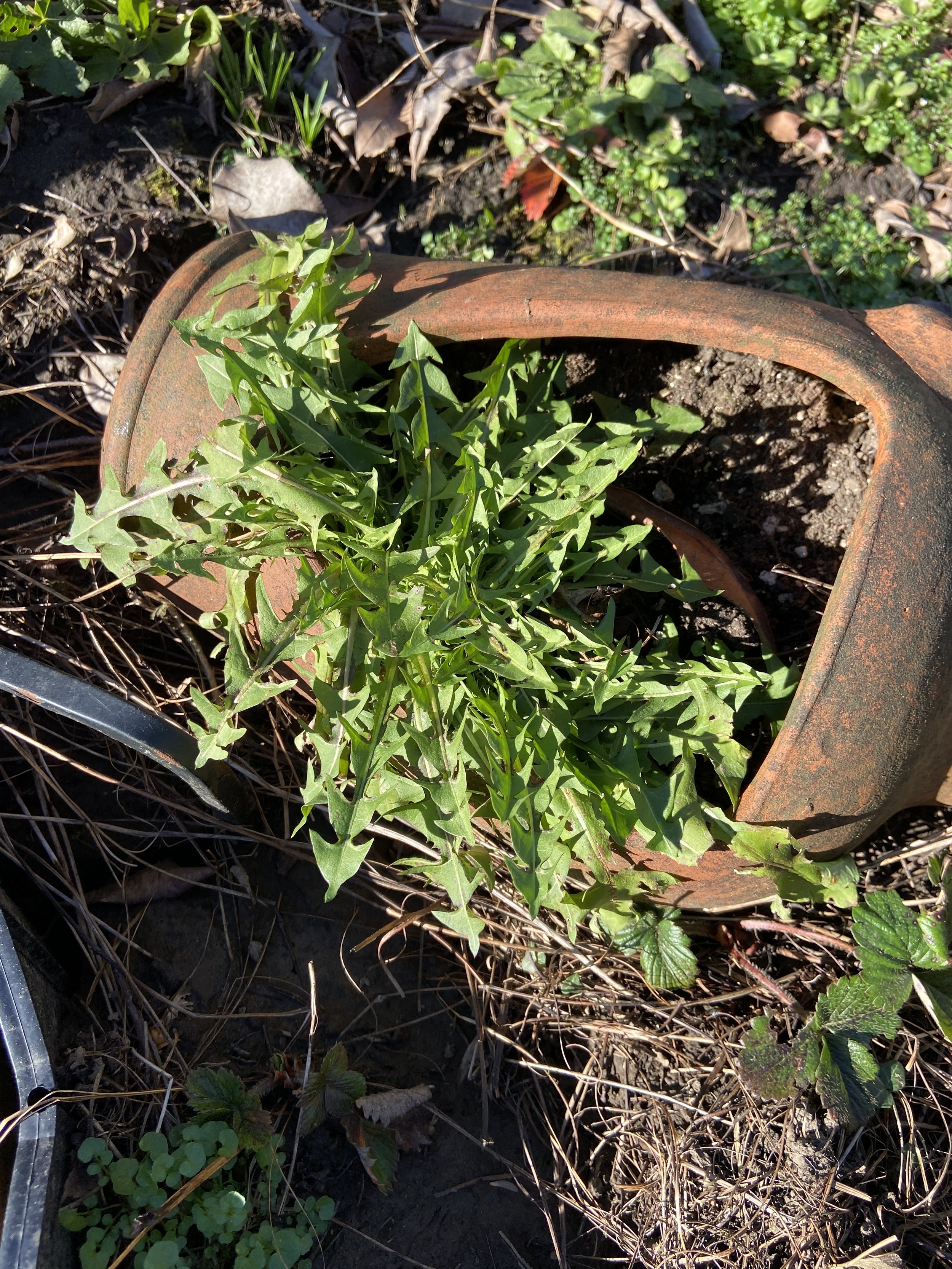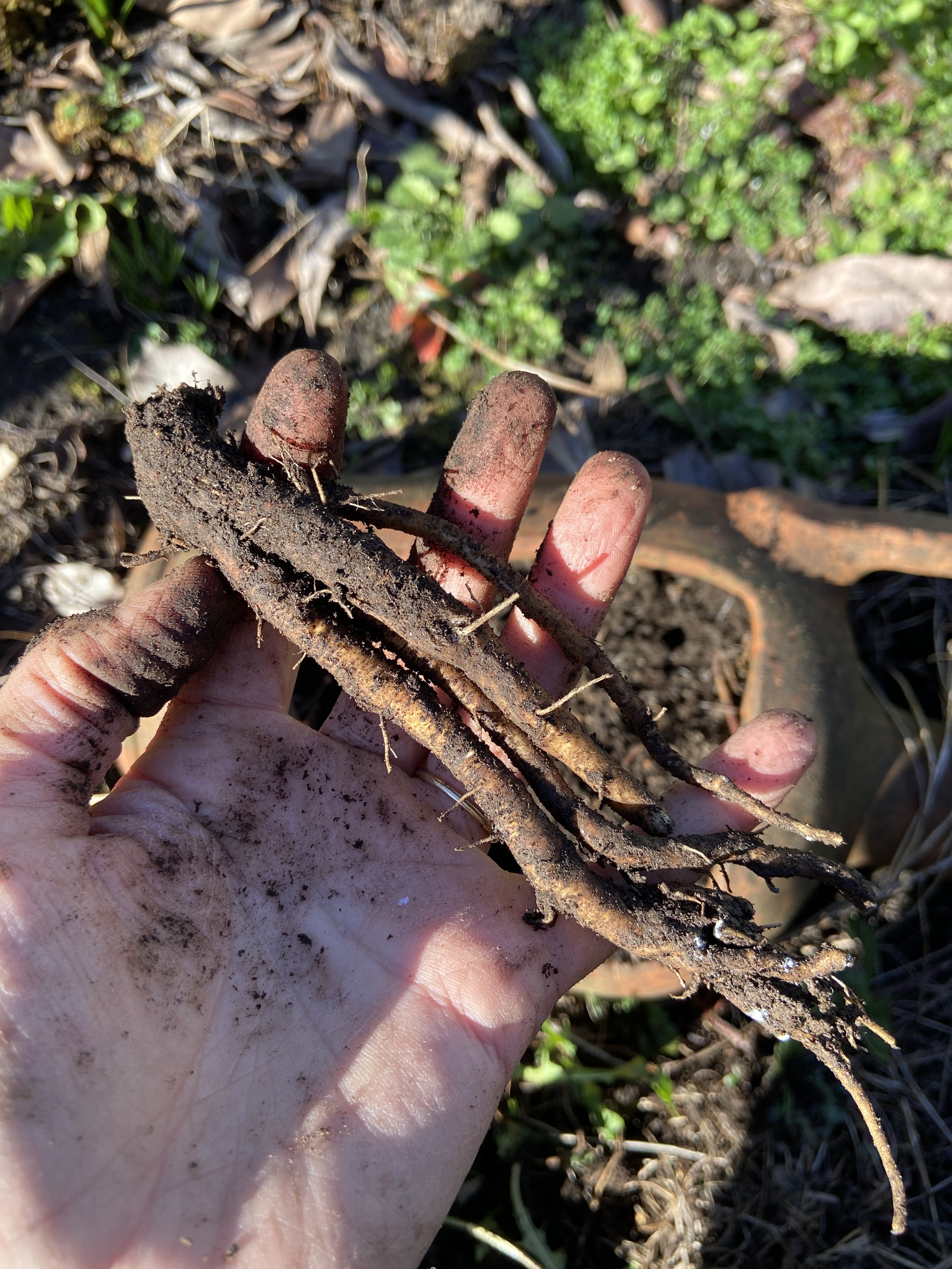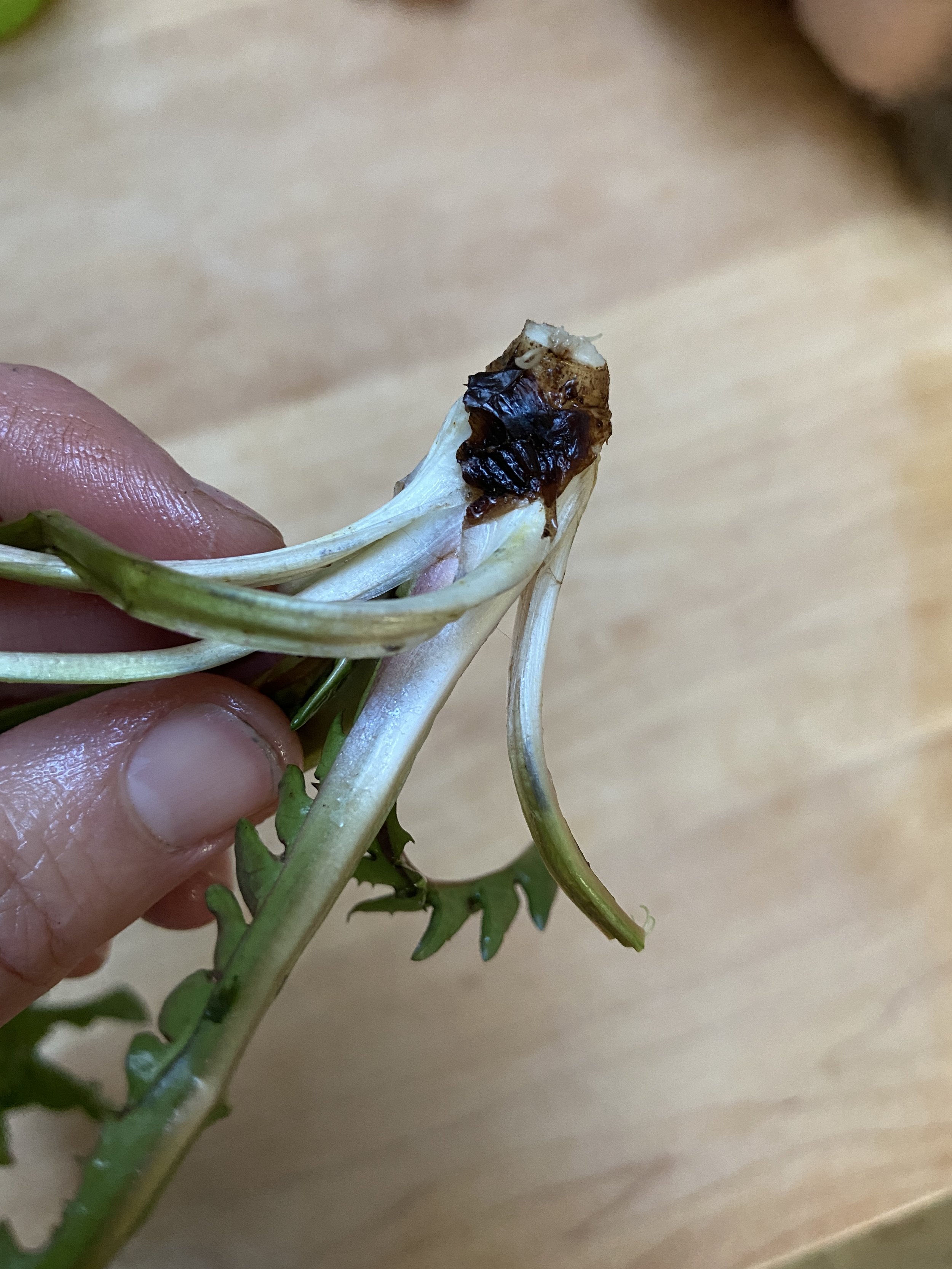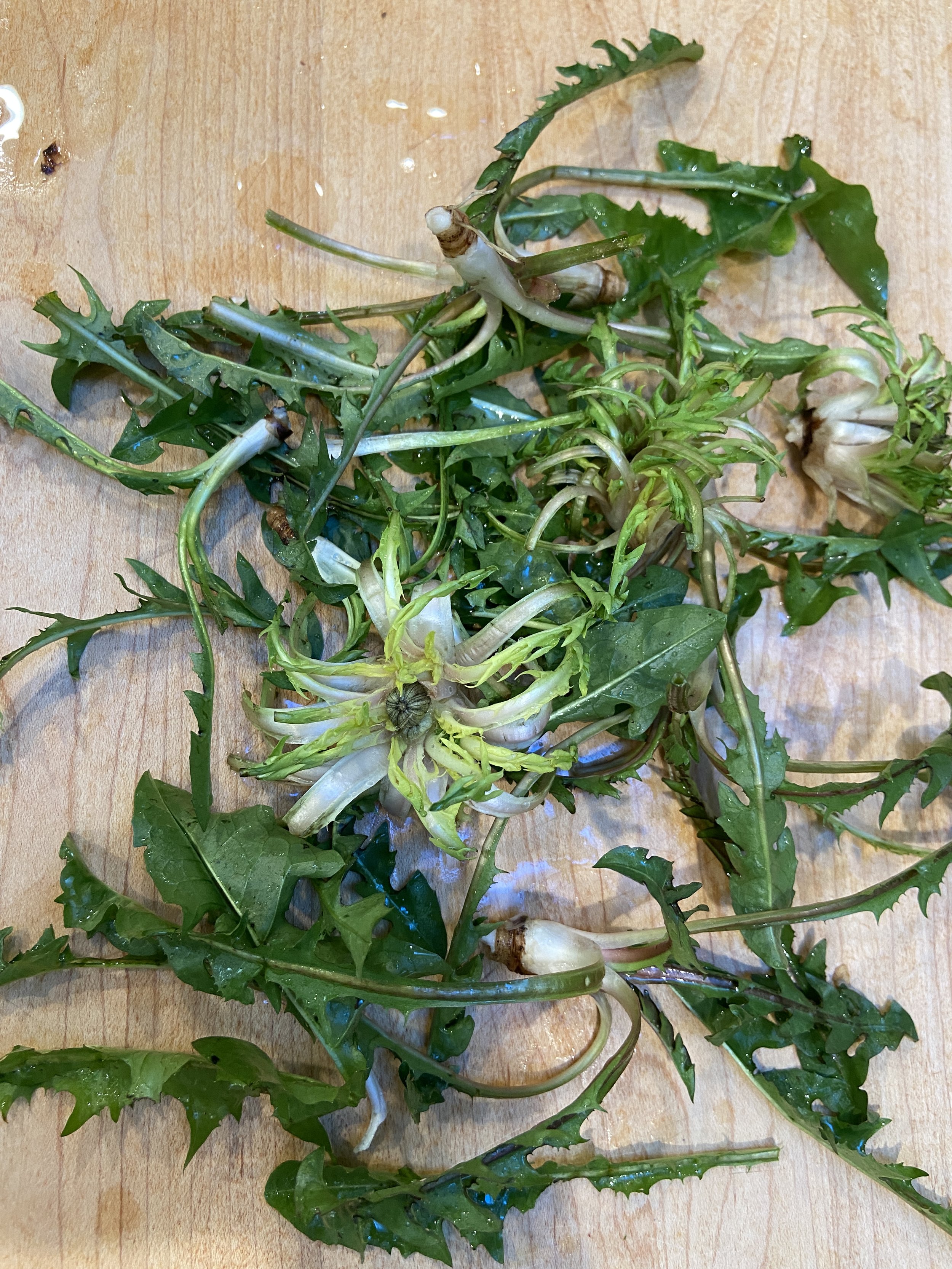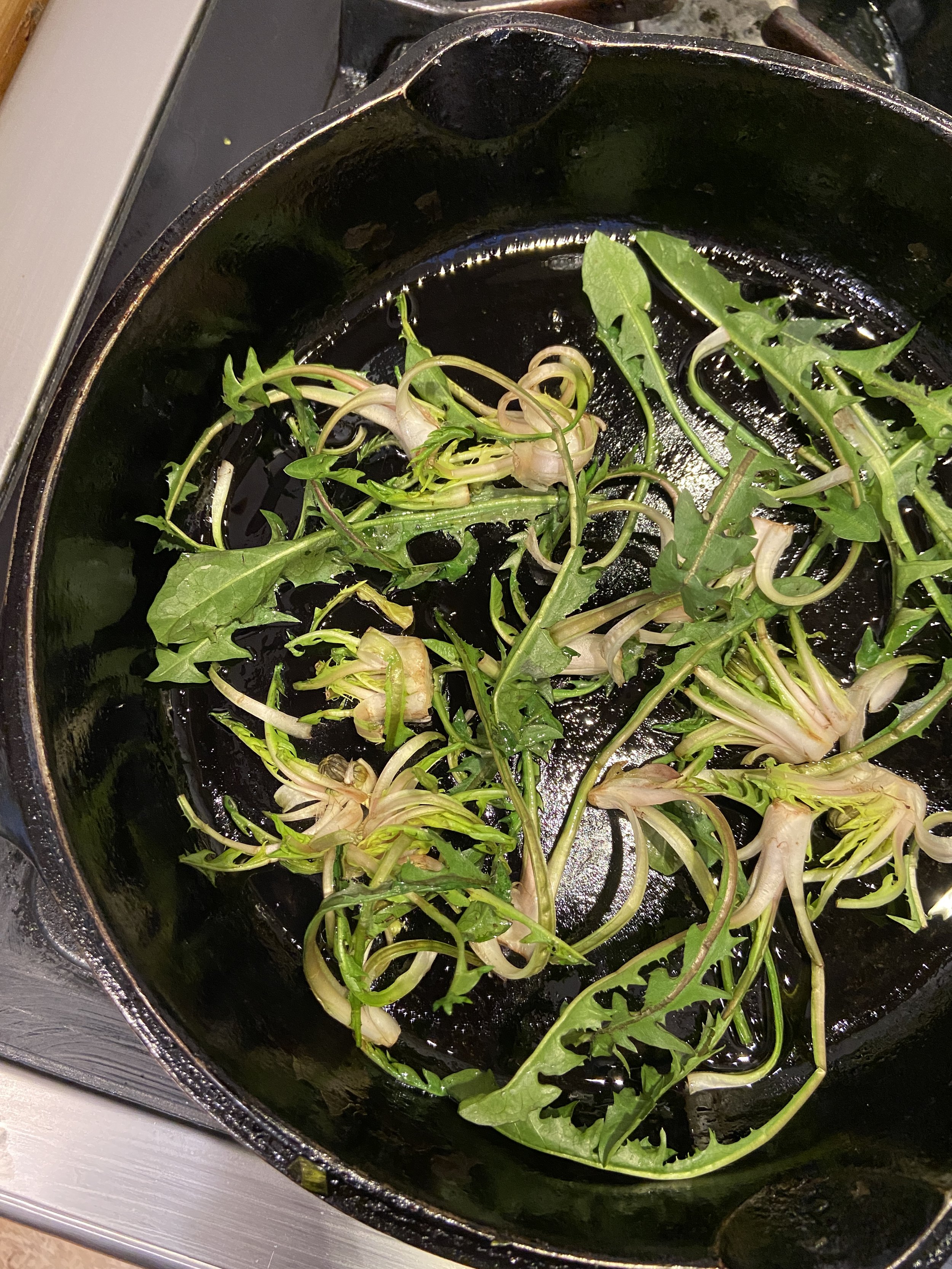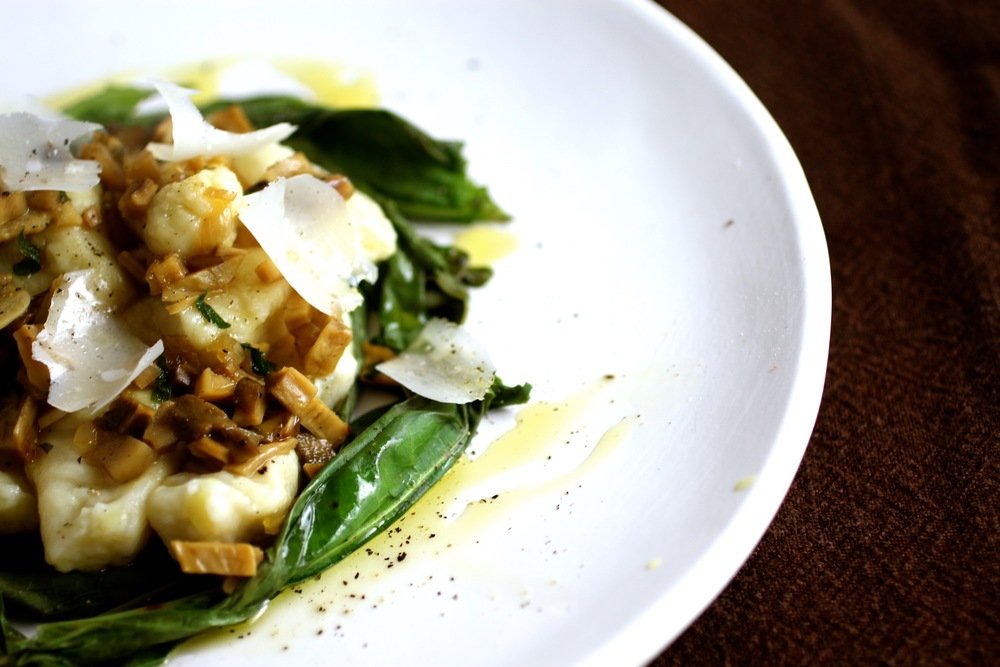Seared Dandelion Hearts
Dandelion hearts (aka dandelion crowns) are even more under-appreciated than dandelion greens, but they are really incredible - kind of like eating an artichoke heart vs. the artichoke leaves. They have the best texture and more mild/less bitter flavor when harvested in the early spring/late winter (or from young plants). It does take a bit of digging to unearth them, but they’re worth it! Because they have similar properties as something like chicory or raddichio, I think they are most delicious seared or wilted with a salty umami dressing with citrus zest. This recipe calls for anchovy, but it can easily be substituted with miso. Would pair beautifully atop polenta or in pasta/ramen noodles!
To harvest: Dig out the dandelion so that you remove the entire base or “heart”. You can also dig up the roots at this point if you want to use them or if you’re in a situation where you’re also weeding a garden and don’t want the dandelion to grow back. Unlike some other foraged wild ingredients, dandelion doesn’t not need to be rationed:) I keep meaning to make dandelion bitters, so maybe I finally will(?)
Ingredients:
6-8 dandelion hearts + tops (you can save the tops for something else if you want)
3 anchovies or 1 tablespoon miso
Juice from 1 lemon or 1-2 tablespoons red wine vinegar
2-3 tablespoons olive oil, separated
Citrus zest - I used orange this time
Black pepper (optional)
Clean dandelion hearts well - I soaked in water a few times and checked between the crevices to make sure dirt was removed.
Chop anchovies and mix with lemon juice using a fork until it creates a paste (a few chunks of anchovy is a-okay). I like to do this in a jar so I can shake it with the olive oil.
Add 1 tablespoon olive oil, mix/shake in jar, and set aside.
Drizzle olive oil in pan (I like to use cast iron for browning) on medium-high. Once hot, add dandelion crowns. Toss for a few minutes, tossing occasionally, until softened and slightly browned. Toward the end, add the dandelion greens and dressing (shake dressing first if it has separated). Toss and remove from heat onto plate.
Top with Citrus zest and black pepper. Add another drizzle of olive oil if needed.
Voila.
Gnocchi with porcini and Wilted wild greens
Gnocchi - the pasta of potatoes. If you see gnocchi as simply a vehicle for toppings then you haven't tried legit gnocchi. Making gnocchi from scratch may take time and attention, but the effort is worth it. The resultant soft, pillowy dumplings are stars of the show as much as any sauce. The first time I had the pleasure of tasting homemade gnocchi was in Turin, Italy when I was there for the Slow Food Terra Madre conference and I can still remember the meal - it was that good. My gnocchi may not quite achieve the same level of perfection, but I'll certainly keep trying.
I've made gnocchi several times in the past, each time with a different topping, and I really like how the richness of the mushroom sauce and the green notes of the wild greens (in this case, curly dock - more on the plant in general here) paired with the simple potato pasta in this recipe. The next time I make it however, I will blend the mushroom sauce with an immersion blender for a smoother consistency that doesn't compete with the soft gnocchi "pillows". Feel free to take just the gnocchi portion of this recipe and experiment with your own combinations, such as different mushrooms, a pesto, or a simple marinara sauce. Recipe serves 4.
Gnocchi
Wee little gnocchi dumplings.
2 pounds of golden potatoes
1/4 cup egg, lightly beaten
1 cup all-purpose flour
Sea salt (fine grain)
Fill a large pot with water. Salt the water, then cut potatoes in half and place them in the pot. Bring the water to a boil and cook the potatoes until tender, about 25-30 minutes.
Working one potato at a time, remove potato halves with a slotted spoon and place on a large cutting board. As soon as possible after removing from the water, peel each potato before moving onto the next (these are, obviously, hot potatoes, but you want to work as fast as possible to mash them while they're still hot). Mash potatoes using a fork to create a mound of potato "fluff" - do not over mash. Save the potato water for later.
Let the potato mash cool for about 5 minutes (you want to prevent the egg from cooking). Join the potatoes into a soft mound, drizzle with the beaten egg and sprinkle 3/4 cup of the flour across the top. Using a spatula, scrape underneath and fold to mix in egg and flour. With a very gentle touch, knead the dough. Knead in more flour if dough is too gummy/tacky. The dough should be moist but not sticky.
Lightly flour a new cutting board and separate potato dough into 8 pieces. Gently roll each 1/8th of dough into a log, roughly the thickness of your thumb. Use a knife to cut pieces every 3/4-inch. Dust with a bit more flour.
Shape gnocchi using a fork to create lines in the middle of the gnocchi, so that they kind of look like footballs. Be sure to lightly touch fork into the gnocchi so that it still stays soft and doesn't break. Set gnocchi aside, dusting with flour if needed until you are ready to boil them. Meanwhile, make the porcini sauce.
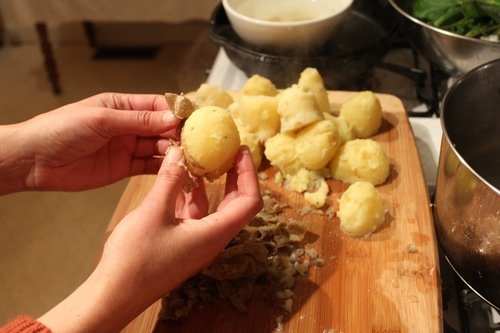


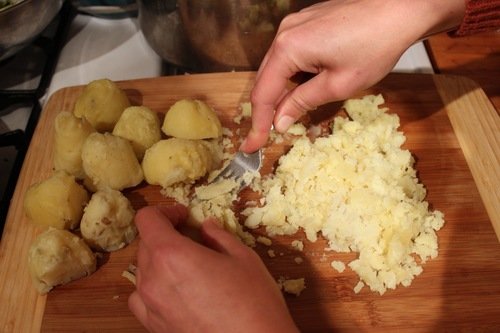
Porcini Sauce
1.5 cups low-sodium chicken broth
0.75 ounces dried porcini mushrooms, rinsed
2 tablespoons extra-virgin olive oil
1 small shallot, minced
1 clove garlic, thinly sliced
1/3 cup dry white wine
2 tablespoons minced fresh parsley
Salt and pepper
Heat broth and porcini in a small saucepan until simmering. Turn off heat, cover, and Let stand until softened, about 5 minutes. Remove mushrooms, reserve liquid, and dice porcini. Heat 1 tablespoon olive oil in a medium skillet over medium heat. Add chopped porcini, shallot, and garlic; cook until lightly browned, 2 to 4 minutes. Stir in reserved liquid, wine, and remaining tablespoon olive oil, scraping up any browned bits. Increase heat to high and bring to boil; cook to reduce, whisking occasionally, about 5 minutes. Stir in parsley and season with salt and pepper to taste. Cover to keep warm.
Cooking and Serving Gnocchi
A few handfuls of foraged dock, dandelion, or other green, thoroughly washed and trimmed
Olive oil drizzle, salt, and pepper, for garnish
Parmesan shavings, for garnish
Reheat the potato water and bring to a boil, adding more water if needed (you need enough water to cover the gnocchi). Cook the gnocchi in small batches by dropping them into the boiling water. Once gnocchi pop up to the top, remove them with slotted spoon ten seconds or so after they've surfaced. Have a large platter ready with dock or other greens that you will be serving with the gnocchi on the plate. Place the gnocchi on the platter on top of the greens - greens will wilt from the heat of the gnocchi. Continue cooking in batches until all the gnocchi are done. Top gnocchi with porcini sauce, a drizzle of olive oil, salt, black pepper, and parmesan shavings.
Chicken & greens Saltimbocca with Brandied Cherries & sage
A unique spin on weeknight chicken.

Brandied cherries are a great complement to the savory chicken and prosciutto.
I have to admit that pounding boneless, skinless chicken breast into a thin sheet and rolling it up with other ingredients isn't something I would have come up with on my own. In fact, I pretty much never buy boneless, skinless chicken breast because it seems like a waste of flavor and texture, but this "transformed saltimbocca" (saltimbocca is traditionally made with veal and prosciutto, rather than chicken and prosciutto) is a great way to rethink chicken dinner and the ingredient combinations are endless. In this version, I used house brandied cherries (so fun to incorporate them into something savory!), spinach, and sage, but other possibilities that have come to mind include: Mashed butternut squash + black olive, gruyere + thyme, parsley + coriander + lemon zest, or even tatsoi + sesame + miso - as you can see, really endless possibilities! A little bit of sweet is nice in any combination, as it pairs nicely with the savory qualities of the chicken and prosciutto. Although the preparation may seem complicated, once you get the hang of it, it's really simple and the actually cooking time is very quick. Below recipe makes 2 generous portions or 4 smaller portions.
2 boneless, skinless chicken breasts (about 1 pound)
Salt and freshly ground black pepper
4-8 thin slices of prosciutto (depending on size, see below)
About 20 fresh sage leaves, divided
1.5 cups fresh spinach
1 tablespoon olive oil, plus more for drizzling
3/4 cup chicken broth
1/4 cup dry white wine
3 tablespoons brandied cherry juice
4-8 brandied cherries (2 per serving)

Chicken cutlets layered with prosciutto, sage, and spinach before rolling up.

A meal of chicken brandied cherry saltimbocca, broccolini, and of course, wine.
Cut chicken breasts in half lengthwise to create 4 pieces and pound using a meat pounder or rolling pin to evenly flatten - pieces should be about 1/4-inch thick. If using a rolling pin, cover chicken with plastic wrap before rolling to prevent cross-contamination.
Sprinkle chicken with salt and ground pepper and lay one slice of prosciutto on each piece of chicken (use more than one piece of prosciutto to cover chicken if needed) followed by 3 leaves of sage per chicken cutlet. Reserve remaining sage leaves.
Heat a skillet on medium-high heat and briefly toss spinach with a drizzle of olive oil and a sprinkle of water. Cook just to wilt, remove from heat, season with salt and pepper, and chop. Arrange spinach in an even layer over the prosciutto slices.
Beginning at the tapered end, roll up each chicken cutlet like you’re rolling up a cinnamon roll. Secure with a toothpick.
Chop 4 of the remaining sage leaves. Heat the tablespoon of oil in a dutch oven or deep skillet on high heat. Cook the chopped sage and chicken rolls until golden brown, about 2 minutes per side. Add the chicken broth and wine and scrape browned bits off bottom of pan with a wooden spoon. Bring liquid to a boil then reduce heat to medium, cover, and simmer until chicken is cooked through, about 8-10 minutes.
Transfer chicken to a platter and remove toothpicks. Continue simmering cooking liquid with 3 tablespoon brandied cherry juice over high heat until it is reduced to about 1/3 cup, or 5-7 minutes then toss in brandied cherries. Drizzle the reduced cooking liquid over the chicken. Serve on top of polenta or other starch with sage leaves and brandied cherries as garnish.

Polenta pairs well with saltimbocca because its soft, simple nature.
Tsukune (Chicken Miso Meatballs) with Nettle Salsa Verde
Izakaya meets foraged greens.

When I have (what I think to be) a unique recipe idea and then find that idea somewhere on the internet, it makes me both happy and sad - happy that the idea is good enough to already be out there and sad that it's already out there. Fortunately, I typically adjust the ingredients enough and add an unusual accompaniment, such as this foraged nettle salsa verde, to make the recipe all my own. The nettle was a volunteer in my snap pea patch and works great as a bright, yet earthy, pairing to the light-bodied and savory tsukune. Remember to be careful when foraging or harvesting stinging nettle - it stays true to its name! Tsukune recipe adapted from here. Serves 4-6.

1 bunch stinging nettles, about 2 cups packed leaves after blanching
1 shallot, chopped
1 clove garlic, chopped
About 1/4 teaspoon sea salt
2-3 tablespoons rice vinegar
1 tablespoon water
1.5 pounds ground chicken, preferably dark meat, divided
1 cup minced scallions (about 4)
1.5 tablespoons white miso
1 tablespoon soy sauce
1 tablespoon brown sugar
1 tablespoon sesame oil
About 1 tablespoon grapeseed or other neutral oil
Shichimi tōgarashi, for garnish
Bring a large pot of water deep enough to submerge the nettles to a boil. Submerge the nettles and cook for 3 minutes.
While nettles are cooking, prepare an ice water bath. Transfer the nettles using tongs to the ice water, cool, then drain and squeeze out excess water. Remove very large or tough stems from the nettles, discard, and blend the remaining leaves and smaller stems in food processor until chopped. Add shallot, garlic, and salt and pulse then incorporate vinegar and water until a texture resembles a coarse salsa. Set aside or refrigerate if preparing more than one hour before making meatballs (can be made up to 24 hours in advance).
Heat a small nonstick skillet over medium heat. Add 1 pound ground chicken and cook, stirring frequently breaking apart pieces, until chicken is opaque and just cooked through, about 2 minutes.
Combine cooked chicken, remaining raw chicken, scallions, and miso in a bowl. Mix together with your hands until a homogenized, sticky mixture forms. Divide mixture into 16-20 meatballs of the same size. Whisk together soy sauce, brown sugar, and sesame oil and keep nearby for use in the next step. If your salsa verde is in the refrigerator, this would be a good time to bring it out to allow it to come to room temperature.
Heat enough grapeseed oil in a large sauté pan to lightly coat pan on medium high. Add meatballs and cook on one side for 2-3 minutes until lightly browned. Drizzle half of soy mixture over meatballs then flip, turn down heat and cook another 2-3 minutes, turning occasionally so that all sides are well-cooked.
Serve meatballs over nettle salsa verde with a drizzle of the remaining soy mixture and sprinkling of shichimi tōgarashi.

Caldo Verde Verde
An even greener spin on an already green soup.

Caldo verde is a traditional Portuguese soup made from potato, chorizo, garlic, and a bunch of leafy greens, such as kale or chard (there’s no reason why you couldn’t use all or partial amount wild greens here either). In this spin, I include even more greens to the recipe by way of parsley and cilantro to give it just a bit more brightness, complexity, and of course, to make it even greener. March is a great time to get into green!
A few friends and I have been doing what we call "#craftsoup" nights where the host prepares soup and everyone crafts as they eat. The purpose of soup is a meal that's easy for the host and easy to eat while you're crafting. I'm always on the lookout for soups to prepare for these nights that are simple, quick, crowd-pleasing, and a complete meal in themselves (one of the rules of #craftsoup night is the host doesn't make anything beyond soup, though I break that rule often). This meal definitely checks all of these boxes and any soup that includes a pound of green leafy vegetables while tasting rich and satisfying has my vote! Serves 4 as a main course, 6-8 as a side.

“The soup can be “veganized” by using sautéed mushrooms instead of the chorizo and replacing butter with olive oil. ”
1 tablespoon extra-virgin olive oil, plus more for drizzling
1 tablespoon unsalted butter
3 garlic cloves, diced
1 large yellow onion, chopped
4-5 ounces chorizo (I like to use Palacios brand purchased at Berkeley Bowl), sliced 1/4 inch thick
2 cups water
2 cups chicken stock
3-4 Yukon Gold potatoes (about 1.25 pounds total) chopped
2 teaspoons white pepper (preferably freshly ground)
Salt to taste
1 pound Red Russian kale (about 1 large bunch), stems discarded and leaves finely sliced - no reason why you couldn’t use wild greens such as dandelion or dock here.
1/2 cup combination of fresh parsley and cilantro, diced (cilantro can be replaced by parsley for the cilantro-haters out there)
Heat the tablespoon of olive oil and butter in a large pot on medium low. Add the garlic, onion and half of the chorizo and cook, stirring occasionally, until the onion softens, about 6 minutes.
Add the water, broth, and potatoes and bring to a boil. Simmer until the potatoes are tender, about 15 minutes.

A great trick for chopping the greens into thin strips is to layer the leaves, roll up, and chop multiple leaves at the same time.
Using an immersion blender, purée the soup and add white pepper and salt to taste. Bring the soup to a boil. Add the kale and remaining chorizo (reserving a few pieces of chorizo for garnish) and simmer until the kale is wilted, about 3 minutes. Just before serving, stir in herbs, drizzle with olive oil and garnish with chorizo and herb sprig.
Serve with: Buttermilk cornbread

Moroccan "Chick-Chick" Salad
Chick peas and chickweed unite.

This salad is a fun play on "chickweed" and "chickpeas" blended together with the Moroccan flavors of pomegranate, cumin, and possibly feta.
My list of favorite foraged greens is long, but chickweed *might* be in the top 5. If not the top 5, then definitely the top 10. Lucky for me, it is one of the most abundant "weeds" available and is also drought resistant - armageddon? Sign me up!
In the Bay Area, you'll find chickweed in abundance after rains when the sun inevitably returns and all the greens start poking up. What I love about this wild green is how soft and delicate the greens are, both in flavor and texture, while still having a slight crunch and very fresh flavor.
To identify chickweed, look for a sprawling plant with oval pointed leaves and possibly small white star-shaped flowers. The most obvious identifying characteristics are:
It does not have milky sap
It has one line of hairs on the side of the stem
If you pull gently on the outer part of the stem, it will separate and there will be a thin inner part that does not separate (try a few times, it might take a bit to get the hang of it)
Some recipes call for cooking chickweed, but I think it's best raw or, maybe, slightly wilted over a soup or by the hot chickpeas in this salad. Serves 2.

3/4 cup cooked chick peas
1 tablespoon plus 2 teaspoons olive oil, divided
1/2 teaspoon cumin
Sea salt
1 tablespoon lemon juice
1 teaspoon pomegranate molasses
4 cups chickweed, washed and dried
1-2 ounces crumbled feta (optional)
Heat cast iron with about 2 teaspoons of olive oil on high. When cast iron is hot, add the chickpeas. Cook, stirring periodically, until beans are lightly browned, about 5 minutes. Once cooked, place in bowl and toss with cumin and a few pinches of sea salt.
“The term “chickweed” is based on the fact that chickens love it —- cute!”
Add lemon juice, pomegranate molasses, remaining olive oil, and a pinch of salt to a mason jar. Whisk with a fork or cover jar and shake to combine.
Combine chickpeas with chickweed in a bowl, drizzle with dressing, and top with crumbled feta (if desired). Serve immediately.

Moroccan chick-chick salad with optional feta.
Dandelion Greens
Nature's bitter bounty.
Foraged dandelion is the “bread and butter” of wild greens. I am not exaggerating when I say any time I walk farther than a block in my neighborhood (and beyond) I come across delicious tufts of dandelion. Oh yes, people stare, but it’s worth coming home with the makings of a salad or ingredients to sauté with some garlic.
They’re rather bitter, which some don’t like but others, such as myself, greatly appreciate. If the bitterness is too much for you, try drizzling with lemon or vinegar.
Suggested uses: Any time you use greens such as in soups and savory porridge, salads, pesto, stir-frys, etc.



